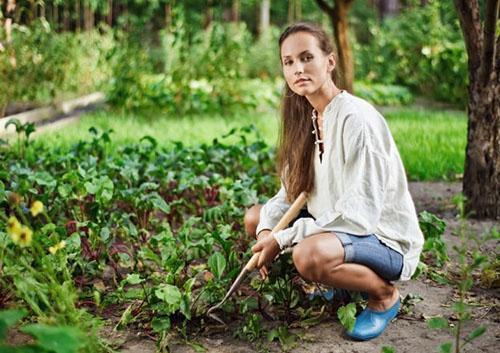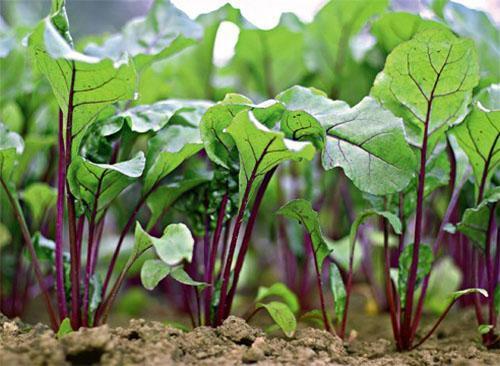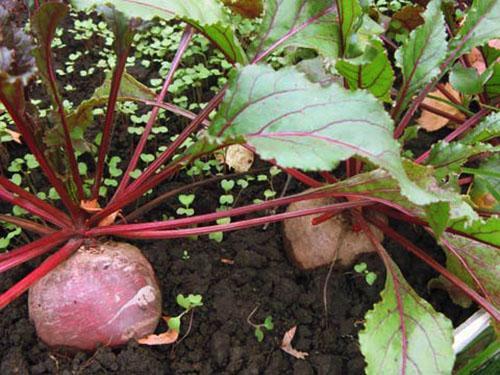What is the difference between caring for beets in July and August?
 Midsummer. All sowing and planting have already been completed, the time has come to create conditions for the plants to harvest. If in farms on huge areas it is impossible to do without treatments against pests and diseases, you can get environmentally friendly products on private farms. How to grow beets so that both tops and roots are healing? How to care for beets in July and later? How do you get tasty healthy root vegetables? There are answers to these questions.
Midsummer. All sowing and planting have already been completed, the time has come to create conditions for the plants to harvest. If in farms on huge areas it is impossible to do without treatments against pests and diseases, you can get environmentally friendly products on private farms. How to grow beets so that both tops and roots are healing? How to care for beets in July and later? How do you get tasty healthy root vegetables? There are answers to these questions.
What a plant needs and signs of starvation

 It is assumed that in July the plant should form a root rosette of leaves and start filling the root crop. August is considered the final month of the formation of the fruiting body and the accumulation of nutrients in it.
It is assumed that in July the plant should form a root rosette of leaves and start filling the root crop. August is considered the final month of the formation of the fruiting body and the accumulation of nutrients in it.
During the cultivation of beets, it requires fertilizing applications of table salt or sodium nitrate. In this case, the root vegetable becomes sweet.
But at any time, the plant should not need nutrition. The condition of the plant will show signs of ailments, and it is known how to deal with them.
- If yellow spots appear on the beet tops, this may mean a lack of potassium. Watering should be done at the root, diluting a glass of lime and 4 tablespoons of potassium chloride in 10 liters of water.
- The tops turned red, which means there is a lack of sodium. Watering beets with salt water is required. We dilute a tablespoon of salt in a watering can and gently pour it under the root. And then we sprinkle the ground ash.
- Small leaves and poor growth of tops - it's time to give nitrogen feeding. If the soil is acidic, then natural infusions of chicken or cow dung at the beginning of development can save the root crop.
 In addition to local dressings, applied as needed, it is necessary to include mandatory dressings in the care of beets in July. These include two additional fertilizing in July with nitrogen-potash fertilizers. Between them, it is necessary to perform foliar feeding with microelements in the complex. For the formation of sugars and chlorophyll in the leaves, iron and magnesium are needed. Sulfur is a part of proteins, boron prevents the formation of voids and rot. Molybdenum prevents the accumulation of nitrates in the root crop, while copper and zinc participate in photosynthesis and protect the root crop from diseases.
In addition to local dressings, applied as needed, it is necessary to include mandatory dressings in the care of beets in July. These include two additional fertilizing in July with nitrogen-potash fertilizers. Between them, it is necessary to perform foliar feeding with microelements in the complex. For the formation of sugars and chlorophyll in the leaves, iron and magnesium are needed. Sulfur is a part of proteins, boron prevents the formation of voids and rot. Molybdenum prevents the accumulation of nitrates in the root crop, while copper and zinc participate in photosynthesis and protect the root crop from diseases.
To obtain a full complex of the necessary elements, you can use special fertilizer mixtures - Agricola-4, Solution or microelements in tablets. Usually, there is no boron and molybdenum in ready-made mixtures, they must be included additionally.
 Complex application of these elements is necessary in July and August. Separately, it is required to spray the plants with boric acid twice 2-3 times per season. It is important that the last treatment takes place in the first half of August. This will allow you to assimilate the trace element and ensure the safety of the roots.
Complex application of these elements is necessary in July and August. Separately, it is required to spray the plants with boric acid twice 2-3 times per season. It is important that the last treatment takes place in the first half of August. This will allow you to assimilate the trace element and ensure the safety of the roots.
Beet farming in July
 So, caring for beets in July is to create conditions for the development of a healthy plant and includes:
So, caring for beets in July is to create conditions for the development of a healthy plant and includes:
- timely watering of beet planting by sprinkling in the evening or in cloudy weather;
- loosening the soil after each watering or rain or mulching it;
- top dressing.
How to fertilize beets in July is decided depending on the soil on which the crop grows. Fertile soil will require a slight adjustment in the composition of the soil, using the fertilizer Kemira universal or Kemira beet, which is simply scattered between the rows and sealed when loosening. Wood ash can be used at any stage of plant development. It drives away insects and adds trace elements and potassium to the soil.
If the soil is poor, then use the composition of ammonium nitrate (7-9 g) and potassium sulfate (5-7 g) per square meter. But afterwards it takes a plentiful watering, 20 liters per unit area. You can use an infusion of chicken in a ratio of 1:10, but pour only into the grooves, without touching the roots.
 Watering beets in the open field should ensure constant soil moisture and water consumption increases with the development of the leaf apparatus. By the end of July, the root crop should be the size of a walnut. At this time, excess plants are removed and 10 cm are left between the roots.
Watering beets in the open field should ensure constant soil moisture and water consumption increases with the development of the leaf apparatus. By the end of July, the root crop should be the size of a walnut. At this time, excess plants are removed and 10 cm are left between the roots.
Beetroot care in August
 August is the final month of caring for the beet bed and the most crucial period for the accumulation of nutrients in the root crop. This month, fertilizing with phosphorus and potash fertilizers is carried out. Knowing that any feeding and watering stops a month before harvesting root crops, you need to calculate the time of the last action.
August is the final month of caring for the beet bed and the most crucial period for the accumulation of nutrients in the root crop. This month, fertilizing with phosphorus and potash fertilizers is carried out. Knowing that any feeding and watering stops a month before harvesting root crops, you need to calculate the time of the last action.
At the beginning of August, it is obligatory to feed plants with microelements on a green leaf. At the same time, it is necessary to scatter into the furrows in a glass of ash and a spoonful of salt per square, loosen the soil to a depth of 7 cm. After that, perform deep watering. Ash fertilizer will provide the plant with potassium in the right form for quick assimilation.
The received food and water-charging irrigation should ensure the filling of the root crop. Application of nitrogen fertilizers during this period will lead to accumulation of nitrates and worsen winter storage. You need to harvest beets with the onset of frost. Root vegetables without light rings and the size of a golf ball are considered optimal for taste.
The smallest amount of nitrates is found in conical root crops. Most of the nitrogenous substances are near the rosette of leaves. When eating round beets, cut to 1/3 of the top.
So, the main nutrients for plant development are nitrogen, phosphorus and potassium. At the same time, during the season, the following amount of fertilizers is applied per 1 square meter of soil:
| Soil type | Nitrogen, g | Phosphorus, g | Potassium, g |
| Sod-podzol. | 12-15 | 6-8 | 15-18 |
| Floodplain | 9-12 | 6-9 | 18-21 |
| Chernozems | 9-12 | 6-8 | 12-15 |
| Peat | 3-6 | 8-10 | 22-30 |
Based on the initial filling of the soil, it is possible to calculate how much fertilizer should be applied during the summer top dressing for the crop.
How to grow beets - video
https://www.youtube.com/watch?v=okNuf0AzGGQ